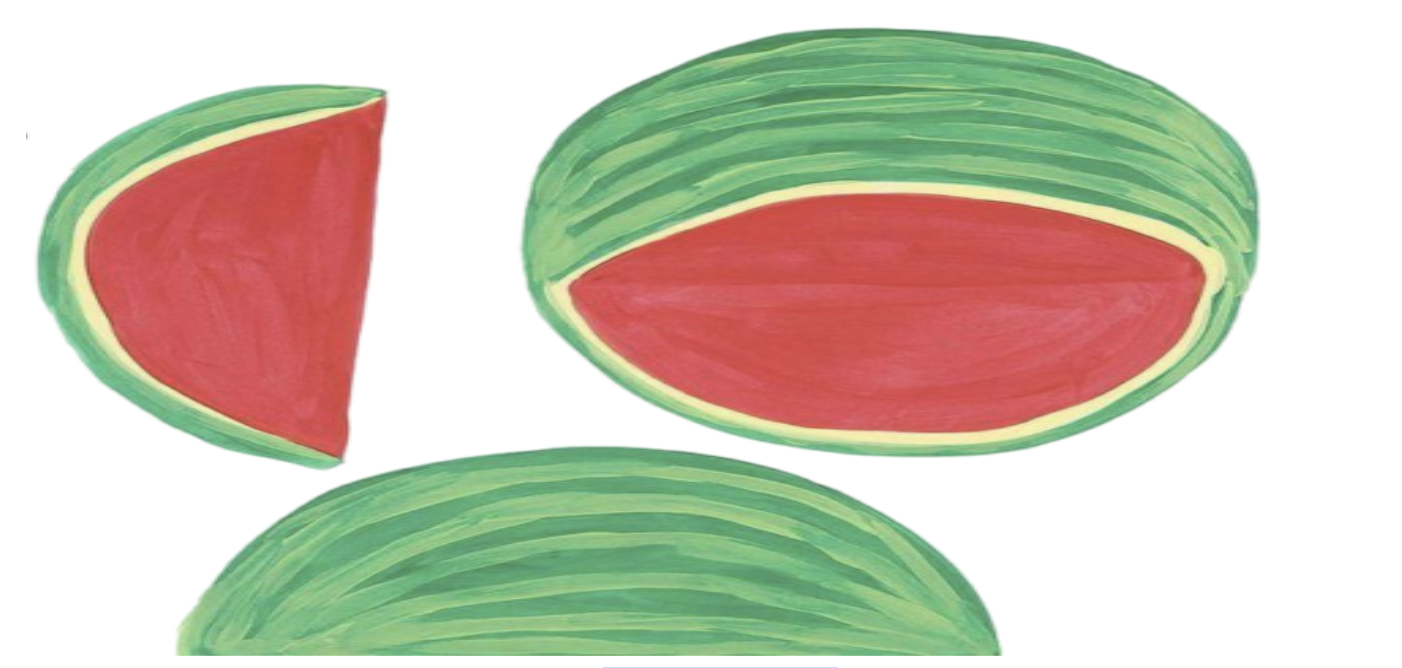The Watermelon: A Tale of Quiet Defiance and the Art of Speaking Without Speaking
Op-ed on Art & Symbolism in Resistance Movements
By Jana Younis
Figure: David Shrigley
ستنتهي الحرب، ويتصافح القادة، وتبقى تلك العجوز تنتظر ولدها الشهيد، وتلك الفتاة تنتظر زوجها الحبيب، وأولئك الأطفال ينتظرون والدهم البطل. لا أعلم من باع الوطن ولكنني رأيت من دفع الثمن. (محمود درويش)
The war will end, and leaders will shake hands, and the old lady will still wait for her martyred son, and that woman will wait for her beloved husband, and those children will wait for their heroic father. I don't know who sold the homeland, but I have seen who paid the price. (Mahmoud Darwish)
The Palestinian watermelon is a symbol of defiance, survival, and the need to claim one’s own identity, especially when the world plots to strip it away.
Let’s rewind. In the late 1960s and 70s, amid rising tensions, the Palestinian flag—a standard of red, green, black, and white—was banned. Imagine: your country’s flag, the pennant of your heritage, the colors of your ancestors, erased. Imagine, for a moment, what it means to be so subjugated that even your colors—the things that would ordinarily belong to the earth, to sunsets, to nature—are seen as criminal.
But human beings are creative. For those who would silence them, well, there’s always a loophole; in this case, it’s the watermelon.
In a wonderful twist of poetic irony, the humble watermelon has the same colors as the Palestinian flag: green on the outside, red on the inside, black seeds dotted across, and a white inner rind. And so, Palestinians began holding watermelons as a form of quiet, subtle rebellion. They found a way to reclaim their colors—no flags, no slogans, just a fruit. A green and red watermelon became a symbol, a refusal to be erased, a non-verbal protest that said everything it needed to say without saying a word.
The Art of the Watermelon Protest: A Cultural Escape Hatch
This is no small act, and is one that echoes far beyond the borders of Palestine. The Palestinian watermelon is part of a broader history of resistance in the Arab world, where those in power have often used fear and force to suppress voices of dissent, and the people, in turn, have found beautiful, quiet ways to speak anyway.
The watermelon didn’t just stand in for a flag; it represented every act of defiance forced to live in disguise. It spoke for the art that couldn’t be painted, the plays that couldn’t be staged, the books that couldn’t be written. Intellectual and cultural confinement isn’t just about physical censorship. It’s about making you afraid even to think differently, to imagine things as they could be. And yet, amid all this suppression, there is always a watermelon. In Palestine and in Lebanon, there are countless variations of these watermelons. They come in the form of poems, songs, paintings, whispered stories—all the things that defy the erasure of identity, the quiet insistence that “we are here,” even if it’s disguised.
A Region’s Shared Legacy of Confinement and Creativity
What’s fascinating is how the story of the Palestinian watermelon, with its simplicity, resonates so deeply across the Arab region. Intellectual confinement has haunted this part of the world for centuries, with regimes, occupations, and dictatorships enforcing “acceptable” thought, controlling what can and cannot be said, seen, or even imagined. In such an environment, art becomes a risky endeavor, and every piece of expression is a delicate dance of what you’re allowed to say without being allowed to say it.
From Egypt to Syria to Lebanon, we see this watermelon effect—a pattern of constrained expression giving birth to art so layered, so coded, that it’s practically its own language. Artists and writers learn to speak in metaphor and symbolism, to use abstraction and humor as shields. Just as Palestinians used watermelons to stand in for flags, entire movements across the region have had to sneak their messages within symbols and hints, relying on shared understanding among the people to hear what they could not say out loud.
This intellectual confinement stifles more than just art; it clips the wings of entire societies. Because when creativity is reined in by fear when you cannot question openly or imagine freely, you start to lose pieces of yourself. Symbols have a funny way of sticking around. The Palestinian watermelon continues to stand in defiance not only of occupation but of the broader system that says, “You are not allowed to be yourself.”
A Watermelon in the Age of Social Media: Speaking Louder than Ever
Today, the watermelon has become something bigger. It’s traveled beyond Palestinian borders, embraced by those standing in solidarity and echoing in protests, murals, and hashtags. You’ll see it splashed across social media, shared in solidarity by people who understand the quiet power of this simple symbol.
In our interconnected world, symbols can’t be contained, and the watermelon has become a universal call for freedom. It’s a reminder of how simple objects can hold entire histories, and how people will always find ways to express themselves, even under circumstances. The watermelon has outlived its original context and has become something larger—a reminder that resistance can be quiet, that identity is not something to be “allowed,” and that even the simplest things, if infused with enough love, history, and defiance, can hold unimaginable power.
The Last Bite
This humble fruit is not just a symbol of Palestinian resistance but a symbol of all the unspoken things in a region where so much goes unsaid. It represents the silent rebellions, the poems that dance around censors, the songs that swell in the hearts of the unheard. The watermelon isn’t just a watermelon—it’s a quiet declaration, a refusal to disappear, and a testament to the extraordinary ways that human beings will always, always find a way to express who they are.
